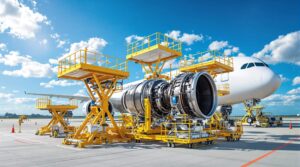The primary application of carbon fiber in aircraft lies in the manufacturing of composite materials. These composites, often referred to as carbon fiber reinforced polymers (CFRP), are created by combining carbon fiber with epoxy resin. The resulting material boasts exceptional strength-to-weight ratio, making it ideal for various components in aircraft construction.
One key area where carbon fiber takes center stage is in the production of aircraft fuselages. The fuselage, a critical component housing the crew and passengers, benefits from the lightweight nature of carbon fiber, contributing to fuel efficiency and overall performance. The use of carbon fiber composites in fuselage construction also enhances durability and resistance to fatigue, ensuring a longer lifespan for the aircraft.
Another vital application of carbon fiber in aviation is evident in wing structures. Aircraft wings must withstand immense forces during flight, and the high tensile strength of carbon fiber ensures that these components remain sturdy and reliable. Additionally, the reduced weight of carbon fiber wings enhances aerodynamics and fuel efficiency, crucial factors in modern aircraft design.
Moreover, the aerospace industry incorporates carbon fiber in the creation of empennage structures, including horizontal and vertical stabilizers. These components play a crucial role in maintaining the aircraft’s balance and stability during flight. The lightweight nature of carbon fiber contributes to optimal performance while meeting stringent safety standards.
Carbon fiber’s versatility extends to interior components, where it is utilized in the construction of cabin elements. From seats to panels, carbon fiber offers a balance between strength and weight, enhancing passenger comfort without compromising safety.
As technology advances, the applications of carbon fiber in aircraft construction continue to expand. From landing gear components to smaller structural elements, the aviation industry embraces the benefits of this innovative material, pushing the boundaries of what is possible in modern aircraft design.
Maximizing strength with carbon fiber aircraft parts
Carbon fiber has revolutionized the aerospace industry, offering a perfect balance between strength and weight. The incorporation of carbon fiber aircraft parts has become a game-changer, enabling engineers to push the boundaries of what was once thought possible. This article delves into the intricacies of maximizing strength through the use of carbon fiber in aircraft components.
One of the key advantages of carbon fiber lies in its exceptional strength-to-weight ratio. Traditional materials often compromise on one end to enhance the other, but carbon fiber manages to provide both qualities simultaneously. The high strength ensures the structural integrity of the aircraft, while the lightweight nature contributes to fuel efficiency and overall performance.
When considering aircraft design, every gram matters. Carbon fiber, being significantly lighter than metals like aluminum and steel, allows for a considerable reduction in the overall weight of the aircraft. This weight reduction directly translates to improved fuel efficiency, reduced emissions, and increased payload capacity. These factors are crucial in an era where environmental sustainability is a top priority.
Furthermore, the inherent properties of carbon fiber make it an ideal choice for components subjected to varying loads and stresses during flight. The material’s high tensile strength ensures that it can withstand forces exerted on different parts of the aircraft during takeoff, flight, and landing. This property contributes to the overall durability and longevity of the aircraft.
The versatility of carbon fiber allows for intricate designs and shapes that might not be achievable with traditional materials. This flexibility in design is crucial in creating aerodynamically efficient structures. Engineers can fine-tune the shape and structure of wings, fuselage, and other components to minimize drag and enhance overall performance.
Another notable advantage is carbon fiber’s resistance to corrosion and fatigue. Unlike metals, carbon fiber does not succumb to corrosion caused by exposure to the elements. This resistance ensures a longer lifespan for the aircraft components, reducing maintenance costs and downtime.
As technology advances, the aerospace industry is witnessing innovations in manufacturing processes for carbon fiber components. Advanced composite manufacturing techniques are being employed to create seamless and structurally sound parts. These techniques include automated fiber placement and resin transfer molding, ensuring precision and consistency in the fabrication process.
Reducing weight through carbon fiber aircraft fuselages
Carbon fiber, a revolutionary material in aviation, has transformed the aerospace industry by reducing weight and enhancing performance. The use of carbon fiber in aircraft panel, frame, body, and other crucial components has become a hallmark of modern aircraft design.
The adoption of carbon fiber panels in aircraft fuselages has been a game-changer. These lightweight yet incredibly strong panels contribute significantly to weight reduction, resulting in improved fuel efficiency. Moreover, the superior strength of carbon fiber ensures enhanced durability and structural integrity, making it an ideal choice for critical body components.
One of the key advantages of utilizing carbon fiber in aircraft design is its exceptional strength-to-weight ratio. Carbon fiber frames, which form the structural backbone of an aircraft, provide unparalleled strength while keeping overall weight at a minimum. This not only contributes to fuel efficiency but also enhances the aircraft’s overall performance and agility.
When it comes to the body of the aircraft, carbon fiber offers unique advantages. The use of carbon fiber body components results in a significant reduction in mass, contributing to increased payload capacity and range. The inherent corrosion resistance of carbon fiber also ensures the longevity of the body components, reducing maintenance costs in the long run.
Let’s delve into a detailed comparison of traditional materials and carbon fiber in aircraft construction, focusing on weight, strength, and durability:
| Material | Weight | Strength | Durability |
|---|---|---|---|
| Traditional Aluminum | High | Good | Moderate |
| Carbon Fiber | Low | Exceptional | High |
As seen in the comparison, carbon fiber outshines traditional materials in every aspect. Its low weight, exceptional strength, and high durability make it the material of choice for modern aircraft design, allowing for optimal performance and efficiency.
Enhancing performance using carbon fiber aircraft interiors
Enhancing aircraft performance goes beyond engines and aerodynamics. The use of carbon fiber in aircraft interiors has revolutionized the aviation industry, providing a perfect blend of strength, durability, and lightweight properties.
One of the key areas benefiting from carbon fiber innovation is the aircraft seat design. Traditional seats often compromise on weight, leading to increased fuel consumption. However, with carbon fiber seats, airlines can achieve a remarkable reduction in overall aircraft weight, contributing to fuel efficiency.
Not only are carbon fiber seats lightweight, but they also offer superior strength, ensuring passenger safety and comfort. The structural integrity of these seats surpasses conventional materials, providing a reliable solution for the demanding conditions of air travel.
Extending beyond the seating arrangement, the aircraft floor benefits significantly from the integration of carbon fiber. The carbon fiber floor panels not only reduce weight but also enhance overall structural rigidity. This translates to improved fuel economy and a more robust aircraft structure.
The sidewalls of an aircraft, often overlooked, play a crucial role in maintaining cabin pressure and structural integrity. Introducing carbon fiber sidewalls ensures a lightweight yet durable solution. This not only contributes to fuel efficiency but also enhances the overall safety of the aircraft.
Moreover, carbon fiber’s versatility allows for its use in aesthetic aspects of aircraft interiors, such as decoration. The material can be molded into intricate and stylish designs, providing a modern and visually appealing ambiance within the cabin.
Imagine an aircraft interior where every component – from the seats to the floor and sidewalls, down to the smallest decorative elements – is crafted with the lightweight strength of carbon fiber. The result is not just an aesthetically pleasing environment but a more efficient and safer flying experience for passengers and crew alike.






